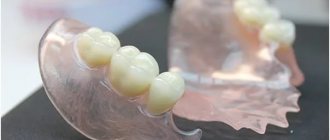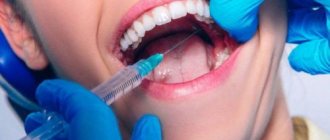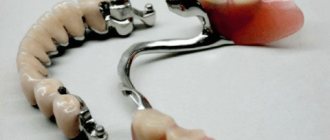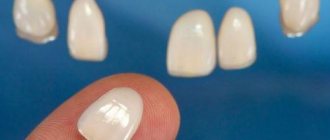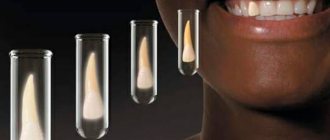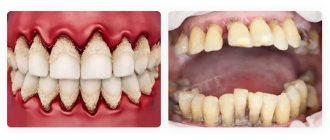From this article you will learn:
- what kind of metal crowns are there for teeth?
- cast crowns - their pros and cons,
- price for 2021.
A one-piece crown is a variant of dental crowns that are made entirely of metal (cobalt-chromium alloy) using one-piece casting technology. This technology assumes that the entire structure is cast at once as a whole, which in the manufacture of solid-cast bridges completely eliminates the need to solder crowns to each other.
A standard solid metal crown does not have any aesthetics, and therefore this prosthetic option is more often used in the lateral sections of the dentition - where such crowns do not fall into the smile line. Despite the lack of aesthetics, cast crowns have a number of advantages. For example, they require less grinding of the tissues of the supporting teeth (compared to metal-ceramics), and also have a significantly lower cost.
Solid metal crown: photo
Cast crowns are made from a cobalt-chromium alloy, which contains about 64% cobalt and up to 30% chromium. There are a lot of options for cobalt-chromium alloys, and they differ from each other in the composition of their minor components. The latter can be molybdenum, tungsten, manganese, silicon, nickel, etc. It is important what kind of alloy the dental clinic (its dental laboratory) will use to make your cast crowns.
Cheap alloys may contain potentially hazardous elements (such as nickel and beryllium), which can cause local allergic reactions and lead to inflammation of the gums around the crown. But these are not all the dangers you may encounter when making solid crowns. And therefore, below we will talk in more detail about their consumer qualities.
What are solid crowns, their advantages and disadvantages
A solid crown is an orthodontic structure used to replace a missing tooth. It is manufactured using the one-piece casting method. Suitable only for restoring chewing teeth; it will not look aesthetically pleasing on the front teeth. The construction is very durable and there are no cracks on it. The minimum service life is 10 years; with proper care, it can be significantly increased.
Advantages:
- affordable price;
- Full compliance with the shape of the tooth, tight fit to the gums;
- manufacturing taking into account the individual structural characteristics of patients’ teeth;
- durability;
- abrasion resistance;
- inertness towards body tissues, lack of negative impact on them;
- during installation, you can do without deep preparation, the teeth are ground down only 0.8 mm;
Flaws:
- unaesthetic appearance;
- high thermal conductivity, which is why eating hot food can cause discomfort;
- there is a possibility of allergic reactions to the components from which the crown is made.
Life time
Cast crowns are made from impressions that were taken from the patient's teeth before grinding. In their production, special technologies are used that make it possible to obtain a strong and extremely durable product that fully matches the shape of the patient’s teeth.
There are no cracks in the structures that bacteria could penetrate. Thanks to the combination of all these facts, the service life of such a crown is at least ten years if it is made with high quality. If you follow the care recommendations, this period can be extended.
Types of solid crowns
- Without coating - this is the most inexpensive option; it looks like a tooth made of polished metal.
- Sputtered – gold is used as the sprayed material, so the design looks more attractive in appearance. It should be taken into account that spraying can negatively affect the mucous membrane.
- With lining. A plastic or ceramic overlay is applied to the front surface, which is visible when a person smiles. During the operation of such crowns, chips of the facing material often occur.
- Combined are bridge-like prostheses made of metal and metal-ceramics. They have an attractive appearance and can be installed in the smile area and in the place of chewing teeth.
If you want to know that this is a one-piece crown, a photo of the prosthesis is given below for informational purposes.
Important points to remember:
1) You should not get solid metal crowns if you have a metal allergy. To be sure, you can test your body's sensitivity to metals. It is very important that the cobalt-chromium alloy from which your artificial crowns or bridges will be made does not contain beryllium or nickel. These additives significantly increase the risk of developing allergies and inflammation of the gums around the crowns.
2) If you already have metal crowns on your teeth (including metal-ceramic), this could be a potential problem. The fact is that the presence of different metal alloys in the oral cavity will definitely lead to the development of electrochemical reactions, i.e. galvanosis will develop. The latter may be characterized by a constant unpleasant metallic taste in the mouth, burning, and the development of diseases of the oral mucosa.
Therefore, only one version of the cobalt-chromium alloy should be used in one patient for prosthetics with solid-cast and metal-ceramic crowns. But even in this case, the risk of developing galvanosis will be present, although it will be significantly lower. Therefore, if you already have metal-ceramics or cast crowns, it is safer to make ceramic crowns from pressed ceramics or zirconium dioxide. We hope that our article on the topic: Reviews of solid crowns was useful to you!
Sources:
1. Personal experience as a dentist, 2. “Orthopedic dentistry. Textbook" (Trezubov V.N.), 3. National Library of Medicine (USA), 4. https://www.realself.com/, 5. "Crowns and bridges in orthopedic dentistry" (Smith B.).
Indications and contraindications for installation
Indications:
- the crown of the “native” tooth is severely damaged;
- malocclusion;
- excessive wear of teeth;
- bruxism;
- abnormal shape, size or location of teeth.
Contraindications:
- chronic periodontitis;
- inflammatory diseases of the oral cavity;
- metal intolerance.
It is important to know. It is rational to install a one-piece crown only if the destroyed tooth tissue cannot be restored with a filling.
How to properly care for crowns
The method of caring for crowns is practically no different from the principles of caring for natural teeth and involves:
- performing oral hygiene twice a day (not only the teeth, but also the tongue should be brushed);
- cleaning the spaces between teeth and the space under dentures. To ensure the proper level of hygiene, it is preferable to use an irrigator: a directed jet helps to quickly and painlessly clean the space under the product;
- nutrition correction - excluding too hard foods and temperature changes from the menu;
- monitoring the condition of the gums and areas where teeth meet crowns (this is where caries most often develops);
- using mouth rinses after each meal (special formulations can be replaced with plain water).
Dentists also advise periodically massaging the gums under the structure. Soft tissues undergo increased pressure, so it is important to stimulate blood circulation in these areas. The gums should be massaged with smooth circular movements clockwise and counterclockwise.
Crown installation process
- The doctor examines the patient's oral cavity and assesses its condition. If necessary, he issues recommendations for rehabilitation.
- An imprint of the tooth and the dentition itself is taken.
- The resulting prints are sent to a dental laboratory. The patient is given temporary crowns, wearing which will help in the future to quickly adapt to permanent dentures.
- Casting the crown in the laboratory, applying the veneering material.
- When the one-piece structure is made, the doctor fixes it in the oral cavity. It is important that the end of the crown is minimally immersed in the gum and does not cause discomfort. If necessary, the prosthesis is modified.
Making crowns is a lengthy process that can take 1-2 weeks.
Manufacturing stages
Based on the impression, a plaster model of the jaw and a wax cap are made in the laboratory. The first step is to create an injection mold.
At the second stage, the metal is poured into the prepared mold in the foundry. After cooling, the manufactured structure is released from the mold. When making a veneered prosthesis, ceramic material is applied to a metal base and the structure is glazed.
At the final stage, the crown is processed with special rubber bands and cutters and polished. If necessary, it can be adjusted.
Features of care
- Daily proper care of dentures is important: brushing teeth and interdental spaces, using rinses and dental floss.
- It is necessary to monitor the condition of your gums.
- You should visit your dentist periodically to help identify the development of gingivitis and periodontitis at an early stage. These diseases lead to crown detachment.
- If the integrity of the prosthesis is damaged, you must immediately contact the clinic for its restoration or replacement.
The one-piece construction sits tightly on the chewing element and hermetically envelops it. Therefore, the patient should not worry about the fact that pathogens or food particles can penetrate under it.
Good to know. Modern solid crowns are not afraid of solid food and are resistant to chemical and thermal irritants.
Materials
There are a number of types of alloys that can be used to make metal dentures. And each has its own specific composition and therefore its own unique physical properties, making it most suitable for certain types of applications.
The following types of materials are used for the manufacture of solid dentures:
- Chromium-based alloys (with the addition of nickel or cobalt).
- Alloys of precious metals.
- Alloys containing titanium.
The most popular are solid gold crowns. The advantage of this type of construction is that gold is a very plastic material and adheres well to the tooth. In addition, such products are very durable in use and their wear rate is equal to natural enamel.
Zirconium (zirconium oxide) is a white powdered metal used to create dental frameworks for crowns, bridges and other dental substructures. It replaces gold or stainless steel.
Do's and Don'ts after having a crown installed
- Water is allowed to be drunk immediately, but the patient will be able to eat food no earlier than after 2 hours.
- If prosthetics was performed on a pin, the chewing pressure on the tooth must be reduced, otherwise the pin and crown may move.
- At first, it is better to limit the consumption of drinks with coloring pigments. You should also avoid foods that are too cold or hot.
- It is recommended to cut solid food into small pieces.
- It is undesirable to eat viscous and stringy food, as it can lead to a gradual deterioration in the fixation of the prosthesis and its loss.
Ranking of dental crowns by nomination
| The most | |
| Aesthetic | Unaesthetic |
| Zirconium | Metal |
| Durable | Short-lived |
| Zirconium/Metal | Metal-plastic |
| Biologically compatible | Unsafe for the body |
| Zirconium/Ceramic/Metal-ceramic with gold-platinum alloy frame | Nickel-based metal-ceramic |
Cost of installing solid crowns
The cost depends on the design features of the prosthesis and the materials that will be used in its manufacture. The cost of the service may also include the cost of obtaining an x-ray and installing a temporary prosthesis.
Specialists at the Saint-Dent Clinic dental clinic in Moscow offer clients high-quality dental prosthetics with solid crowns with a guarantee of long-term use. The clinic's doctors have many years of experience and regularly take specialized courses in the best dental centers in Europe, America and Asia. To provide medical services, the latest equipment and modern certified materials are used. Contacts of the clinic are located here CONTACTS. You can find out the cost of services in this PRICES section.
Is a metal crown on a chewing tooth harmful?
There is no clear answer to this question. I think it is harmful, although each case is individual. There are patients for whom the placement of steel products is contraindicated due to a genetic characteristic of the body that causes allergic reactions to metal, including galvanism, when the potential difference of metals in the mouth begins to produce an electric current. And this is accompanied by quite unpleasant sensations.
Therefore, before prosthetics, it is recommended to undergo a test for allergic reactions. If the result is positive, the client is offered an alternative type of prosthesis - metal-free crowns on the teeth.
Installation of non-metal crowns
on teeth I offer patients in such cases:
- If you need to restore teeth with a high functional load.
- The bone tissue of the tooth is destroyed to the base.
- The closing surface of the chewing units is heavily worn.
- Installation of bridge structures is required.
The rigidity of the frame and the duration of wearing the crown depend on the method of manufacturing the prosthesis. Today, only cast elements are used in prosthetics. They fit tightly to the base, preventing the penetration of harmful bacteria. Therefore, the risk of developing caries on prosthetic teeth, after high-quality installation of metal crowns, is zero.
